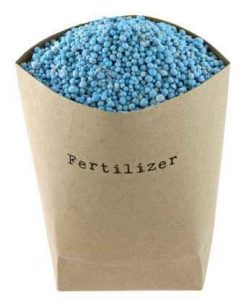The increase in price of fertilisers means we can no longer afford to just ‘throw on another handful’ which is, in any case, bad for the environment and can be counter productive. Hopefully these tips will help you make best use of fertiliser
 Use a proper soil test kit to determine the actual levels of major nutrients and the pH of the soil before applying fertilisers. Don’t forget that an acid soil will not enable many vegetables to take full advantage of the nutrients present in the soil.
Use a proper soil test kit to determine the actual levels of major nutrients and the pH of the soil before applying fertilisers. Don’t forget that an acid soil will not enable many vegetables to take full advantage of the nutrients present in the soil.
Apply More Fertiliser for Light Soils
Light and free-draining soils, usually sandy in composition, lose nutrients more quickly than other types, especially in rainy spells. Apply fertiliser more frequently on these soils, especially nitrogen fertilisers to maintain levels.
Apply Less Fertiliser for Clay Soils
Heavy clay soils and soils containing a lot of organic matter require less frequent application. This is because both substances act as reservoirs holding the nutrients and releasing them slowly over time to the plants
Very Acid or Very Chalky Soils
Phosphates and potash become more soluble in an acid soil, making them easier for rain to wash away. In chalky (alkaline) soils, phosphate becomes insoluble when mixed with the calcium present in chalky soils. In both cases, divide the application into two or three and apply over the growing season.
Lime and Fertiliser
Never apply or store fertiliser and lime together. There will be a chemical reaction between the lime and the nitrogen in the fertiliser, making neither effective. Especially when growing vegetables, check and adjust if necessary the pH (acidity) of the soil. Acid soils may contain nutrients but they are less available to the plants.
Feed at the Right Time
Only add fertilisers to plants before and during the growing season. Applications made after the season will just be washed out of the soil and not do any good unless you use an over-winter green manure crop to hold them for the next season.
Boosting Failing Plants
If plants are showing signs of nutrient deficiency then you can give a boost using liquid fertilisers that are absorbed more quickly by the plant. Sometimes the problem isn’t the amount of nutrient available but a lack of micro-nutrients preventing take-up by the plants. Try a spray of seaweed extract or a foliar feed with Epsom salts to release the nutrients. (see Additional Elements in Plant Nutrition)
Make Your Own Liquid Feeds
If you have comfrey or nettles available you can make your own liquid fertiliser by adding the leaves into a barrel of water and allowing them to ferment for three of four weeks. This will make a fertiliser high in potash, great for tomatoes and hanging baskets.
A high nitrogen liquid feed can be made by suspending a hessian sack of horse or sheep droppings into a barrel of water until the water turns the colour of tea.
Controlled Release Fertilisers
When growing in containers or baskets you can use controlled release fertilisers. These gradually dissolve over the growing season ensuring a constant supply of nutrient is available to the plants over the season.
Specific fertiliser requirements and feeding plans for various vegetables are listed along with other articles in this section.



